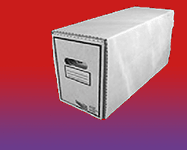Frequently Asked Questions
- What will fit in a DrawerBox?
- I prefer plastic boxes to protect my comics from water. Will you ever make a corrugated plastic version?
- How many comics will a DrawerBox hold and how does this compare to a long box?
- Can you reach the comics in the back of the drawer?
- How can the drawer be removed completely?
- How can comics tipping forward or backward when a drawer is half full be eliminated?
- Can the drawers be left open?
- Will the box tip when a drawer is opened?
- Can I just order shells and use my own long or short boxes?
The inside width of the drawer for the long and short comic size is 7 11/16". It was designed to accommodate all products for Modern or Silver Age comics. The inside clearance is 11 5/8". This is tall enough to even clear the tabs on Mylars™
Note that, while a Golden Age comics will fit inside the drawer without a board, DrawerBoxes were not designed to hold products such as backing boards for Golden Age or Silver/Gold comics. Our own experiences with old-fashioned boxes over the years revealed that if the container was too wide the comics inside could be subject to slipping to the side as the contents shift from moving and the edges become bent, even with boards. For that reason we felt it was important to design ours with closer tolerances so the comics fit properly. This meant that we had to choose between a "one size fits all" approach that man long and short boxes take and the narrower width designed especially for Silver and Modern Age comics.
The drawer of the magazine/slabbed comic DrawerBox has a spacious 9 ½” width and has an inside clearance of 13”. Virtually any magazine will fit except for the original Life Magazines and Treasury Edition comics. We also recommend the long or short comic DrawerBoxes for the original National Geographic magazines due to their scaled down size.
We investigated making the DrawerBoxes out of corrugated plastic before introducing them into the marketplace. One of the key elements to make a DrawerBox function is its durability. We found that corrugated plastic lacks the rigidity of heavier weights of cardboard that were needed to make it stackable. While we were able to custom manufacture cardboard to meet our specs, we could not do so with corrugated plastic. This is why corrugated plastic never caught on in the shipping industry.
Additionally, contrary to many people's assumptions, corrugated plastic boxes are not waterproof. Water will still come in the seams if the storage area floods. Since plastic materials would triple the cost, it did not seem to be a practical solution. Should there be innovations in that industry we will revisit the issue.
DrawerBoxes will hold approximately 235 comics with boards and bags and more if boards are not used (although we recommend protecting your comics with boards). There are several slightly different lengths of long boxes on the market; however, we have found that 29" long boxes hold approximately 270 comics with boards and bags. DrawerBoxes hold approximately 15% fewer comics than a 29" long box. Note that these counts assume an average page count for a comic and filling the box with 1"-2" of open space.
We have heard claims that a long box holds 300 comics. We believe that this count comes from years ago when most long boxes were 29" long and before boards and bags were created.
DrawerBoxes are designed with a tab at the end of the drawer. The purpose of this tab is to give you a "signal" when you are at the end of the length of the drawer so you do not accidentally remove the drawer too far, spilling the drawer and its contents on the floor. The tab will actually catch the drawer 4" before the end of the drawer as you pull it open. While the goal of a DrawerBox is to eliminate the need to lift boxes, on occasion you may wish to remove a drawer entirely to review its contents elsewhere or to relocate the drawer to a different shell. You can do so one of two ways: Spread the sides of the shell away from the drawer as you pull it out. You can also remove the drawer by giving it a sharp yank as you get to the tab to force it past the stop. Be aware that if you use the later method, it will gradually deteriorate the tab over time so that it provides less of a stop.
Some collectors have indicated the desire to not have the stop at all. This can be accomplished by trimming a very small amount (1/16") of the tab both sides of the end flap with scissors before assembling the drawer. We suggest doing this on only the back end of the drawer so that you can restore the function later by reversing the end of the drawer used as the back end.
Since the shells are designed to support the weight of the units stacked above them and keep the weight off the drawers, your storage system will remain stable even with a drawer removed.
Every storage container, including long and short boxes, suffers from this problem. We have located a comic "sizer" in the marketplace that utilizes clips that extend over the outside of the box and can be moved to accommodate any quantity of comics. Unfortunately, this product is not compatible with DrawerBoxes. We are currently developing a sizer device for DrawerBoxes.
Absolutely. The drawer can be extended open within 4" of the end of the drawer and they will stay in place in the shell, even if you walk away. We have designed the height of the drawer to match the inside dimension of the shell to maximize the support it receives when open. The front of the drawer will hang downward approximately 10 degrees. This will enable you to remove comics from the back of the drawer more easily.
This will only be a problem when the top box in a stack is pulled open more than halfway, so the center of gravity is past the front edge of the box beneath it. All lower boxes will be stable when pulled out, even if they are extended to their full length (See above). The tipping issue is a minor problem and is easily corrected a number of ways. The simplest solution is to place another box such as a long box on top of the stack to act as a counterweight. Another solution is to attach a trim board like a chair rail to the wall on top of the back edge of the top box. Another solution, particularly if your DrawerBoxes are stored in a closet, is to install a shelf on top of the back of the top box. This will provide you with additional storage as well as keeping the top box stable when fully extended.
Well, yes we can sell just shells. You can call us to order direct. However, we do not ordinarily offer that option because our experience has shown that most customers quickly become dissatisfied with that option.
Keep in mind that our DrawerBoxes are designed to be an integrated system. They are a mechanical device, not just a storage box. Like any mechanical device, to work properly all the parts must fit so they work together. The overall length of the DrawerBox is 26". If you use a 29" long box it will stick out. And you would have to reach into the shell several inches to withdraw a short box. The 26" length was not an arbitrary decision. The extra comics in the length of a 29" box increases the weight of the drawer by about a 15% increase, around 8 pounds. That manifests itself 2 ways: since that extra weight is multiplied by the number of boxes you stack, the maximum height they can be stacked is reduced. More significantly, the drawer becomes heavier to pull out.
Assuming you don't mind pulling the heavier weight, you also have to make sure the front of the box that you are pulling on also can withstand the weight. Our drawers have 4 layers of cardboard around the handle to help support them. Most long boxes do not, which means you are pulling more weight with less durability and over the long term they will not hold up. Before attempting to use a regular long or short box as a drawer you should try this simple test: Fill your current long (or short) box full of comics and set it on the floor. While holding the handle, pull the box across the floor the length of the box. Then push it back to its original position. Then grab the handle again and repeat this procedure approximately 100 times. This is duplicating the force you are putting on the front of the box in only one year assuming it is opened twice per week. Most long boxes will bend and tear as the cardboard breaks down in this simple test.
The width of the drawer has to be narrow enough to fit in the housing, but not too narrow or you will have a sloppy operation, not to mention defeating the safety tabs. DrawerBoxes drawers are designed with tabs on the end to signal when the drawer is almost all the way out. This is important because most people are inclined to give the drawer a firm tug to extend the drawer. Without the tab, it is easy to pull the drawer out too far and spill the comics on the floor. Potentially cataclysmic if you pull out a drawer from the 4th level or so!
Height is also crucial. Obviously if the drawer is too tall the drawer will not fit. But even if it is slightly shorter problems may develop because it is normal for the outside to sag a little as weight is applied. This will cause the drawer to pinch and wedge inside. And if the drawer is too much shorter it will not hang properly when it is pulled open since it is the height of the drawer against the top of the shell that keeps it in place when extended. A drawer that is too short will simply fall out if it left too far open. In those cases you have to either remove the drawer entirely every time you open it or never leave the drawer more than partially open, limiting your ability to get to the contents in the back.
We have spent a number of years perfecting our design to ensure our DrawerBoxes work as well as possible. Even though the concept is deceptively simple, considerable engineering went into making sure they would work correctly.
There are a number of manufacturers making both long and short boxes, each one making theirs to a different specification. This is why we realized in the beginning that there was no way we could design a product that would fit everyone else's boxes and still work correctly.
You should also be aware that the BoxSort™ Upright Dividers will not work in other long and short boxes since they must match the interior length precisely and be able to lock under the handle to secure them.

